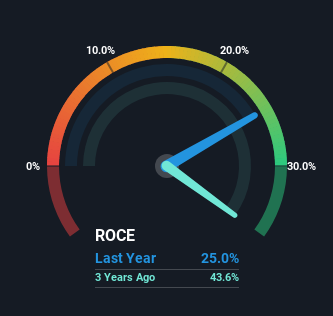
If we're looking to avoid a business that is in decline, what are the trends that can warn us ahead of time? Businesses in decline often have two underlying trends, firstly, a declining return on capital employed (ROCE) and a declining base of capital employed. Basically the company is earning less on its investments and it is also reducing its total assets. On that note, looking into Herbalife (NYSE:HLF), we weren't too upbeat about how things were going.
Understanding Return On Capital Employed (ROCE)
For those who don't know, ROCE is a measure of a company's yearly pre-tax profit (its return), relative to the capital employed in the business. Analysts use this formula to calculate it for Herbalife:
Return on Capital Employed = Earnings Before Interest and Tax (EBIT) ÷ (Total Assets - Current Liabilities)
0.25 = US$407m ÷ (US$2.6b - US$976m) (Based on the trailing twelve months to June 2024).
Therefore, Herbalife has an ROCE of 25%. In absolute terms that's a great return and it's even better than the Personal Products industry average of 16%.
View our latest analysis for Herbalife

Above you can see how the current ROCE for Herbalife compares to its prior returns on capital, but there's only so much you can tell from the past. If you'd like to see what analysts are forecasting going forward, you should check out our free analyst report for Herbalife .
So How Is Herbalife's ROCE Trending?
We are a bit worried about the trend of returns on capital at Herbalife. About five years ago, returns on capital were 42%, however they're now substantially lower than that as we saw above. And on the capital employed front, the business is utilizing roughly the same amount of capital as it was back then. Companies that exhibit these attributes tend to not be shrinking, but they can be mature and facing pressure on their margins from competition. So because these trends aren't typically conducive to creating a multi-bagger, we wouldn't hold our breath on Herbalife becoming one if things continue as they have.
On a side note, Herbalife has done well to pay down its current liabilities to 38% of total assets. So we could link some of this to the decrease in ROCE. What's more, this can reduce some aspects of risk to the business because now the company's suppliers or short-term creditors are funding less of its operations. Since the business is basically funding more of its operations with it's own money, you could argue this has made the business less efficient at generating ROCE.
The Bottom Line On Herbalife's ROCE
In summary, it's unfortunate that Herbalife is generating lower returns from the same amount of capital. We expect this has contributed to the stock plummeting 81% during the last five years. Unless there is a shift to a more positive trajectory in these metrics, we would look elsewhere.
If you'd like to know more about Herbalife, we've spotted 4 warning signs, and 2 of them make us uncomfortable.
Herbalife is not the only stock earning high returns. If you'd like to see more, check out our free list of companies earning high returns on equity with solid fundamentals.
Valuation is complex, but we're here to simplify it.
Discover if Herbalife might be undervalued or overvalued with our detailed analysis, featuring fair value estimates, potential risks, dividends, insider trades, and its financial condition.
Access Free AnalysisHave feedback on this article? Concerned about the content? Get in touch with us directly. Alternatively, email editorial-team (at) simplywallst.com.
This article by Simply Wall St is general in nature. We provide commentary based on historical data and analyst forecasts only using an unbiased methodology and our articles are not intended to be financial advice. It does not constitute a recommendation to buy or sell any stock, and does not take account of your objectives, or your financial situation. We aim to bring you long-term focused analysis driven by fundamental data. Note that our analysis may not factor in the latest price-sensitive company announcements or qualitative material. Simply Wall St has no position in any stocks mentioned.
About NYSE:HLF
Herbalife
Provides health and wellness products in North America, Mexico, South and Central America, Europe, the Middle East, Africa, China, and the Asia Pacific.
Undervalued slight.
Similar Companies
Market Insights
Community Narratives




